The Beginner's Computer Handbook - Understanding & Programming The Micro
"Microcomputers are small multi-purpose computers. You can play games on them, draw pictures, and sometimes even make sounds and music. They can also do complicated sums very quickly, and you can keep diaries and catalogues of records and slides, or anything else you collect."
On Saturday morning my wife and I went to our local church fête, at St John's Church on Chingford Road in Walthamstow, where both my parents and my sister got married. I don't go out of any religious conviction or obligation, but I do think it is worth supporting as it is one of the few centres locally which runs volunteer evening groups for local kids. We usually spend most of our money on the book stall where we can pick up throwaway stuff astonishingly cheaply (we are talking six paperbacks for £1 cheap!). Anyway yesterday for the princely sum of 30 pence I purchased a 1983 hardback edition of "The Beginner's Computer Handbook - Understanding & Programming The Micro" by Judy Tatchell and Bill Bennett, edited by Lisa Watts, published by Usborne Publishing.
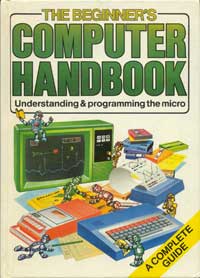
"The book then describes how a micro works, and how it makes pictures and different sounds. It shows the inside of a micro with its tiny silicon chips which do all the processing. You can also find out how some micros can be linked to computers thousands of miles away to bring all sorts of information into your own home. Micros can be used to control robots, or other electronic equipment, such as model railways, too."
It has been a very entertaining read, and one that has really brought home to me how much the arrival of computers in the home has changed things for society over the 21 years since it was published. It still seems to have that wonderful utopian feel I normally associate with the 60's that computers are going to make everything easier in the future. It also has some really funny British cultural quirks - like this diagram on a page about getting programs for your micro:
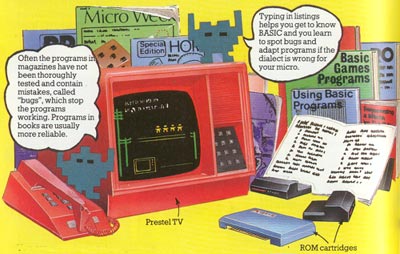
"Often the programs in magazine have not been thoroughly tested and contain mistakes called 'bugs', which stop the program working. Programs in books are usually more reliable."
Of course, there is nothing inherent in publishing a magazine that should make the proof-reading or the error testing of programs inferior, but the implication is that books are just so much more classy and expensive to produce that they must have higher production standards in their code listings. Aside from that fact, you notice that distribution mediums were more expensive then - it didn't make economic sense for magazines or books to put the code onto a cover-mounted tape, whereas now you can't move in the newsagent for computer magazines with cover-mounted CDs or DVDs crammed with freebie software.
I am very taken with the diagrammatic approach in the book to showing how computers do, and don't work. If the BBC isn't careful the next project I work on may end up with a similar visual crib-sheet type approach to information giving - especially if I can get a guarantee that it will feature little talking robots
The reason I absolutely had to purchase the book though was that as I flicked through it I recognised the end section - print outs of the code for 13 different games to play, written in a generic version of BASIC that would run, with minor adjustments, on the BBC Micro, ZX Spectrum, ZX81, VIC 20, Pet, Apple and TRS-80. Although I'm sure I never owned the book, the artwork was so familiar I must have at one point as a child borrowed at least the last section (which had also been published as a standalone book "Computer Spacegames") from the library. Looking at it now the stunning thing is not the code itself - and let's be honest with a lowest common denominator of the ZX81 it was never going to be up to much. No, it is the attention to detail in setting up the "space scenario" that the game depicts. One example is the "Alien Snipers" game illustrated below - with a colour picture and the following blurb:
"You are the captain of an interstellar cruiser which, through damage to one of its hyperspace motors, has strayed into a forbidden area. Alien sniper ships are attacking you and, to make things worse, are using a jamming device on your radar which makes it give false readings. Luckily your computer knows a code which you can use to work out the correct locations of the enemy ships. But you must be quick - they don't stay in one place for long! Your computer will print a letter (the false enemy location) and a code number. You must think through the alphabet by that number of letters and type in the letter you get to. E.g. for M 4, you must type Q, and for C 2, you must type E and so on. Typing in a letter automatically triggers off your laser gun, so if your letter is correct you'll score a hit. You can choose the difficulty of each game. This is a number between 1 and 10 and is the maximum number of letters to be added on each time. You get 10 alien snipers each game. See how many you can hit."
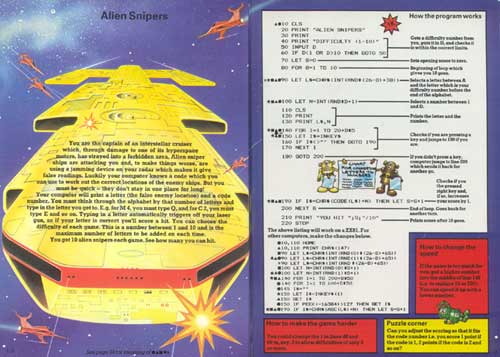
Now despite its hi-tech talk of lasers, hyperspace, aliens and radar - the game action itself is simply a test of counting through the alphabet quicker than your computer can count through to 200+D*50. Still, as it was aimed at kids I guess it at least has some educational merit.
However, my favourite part of the book is a little box-out on Page 91, with the most optimistic approach to debugging I have ever seen. If only I could apply this sort of product process to my work today.
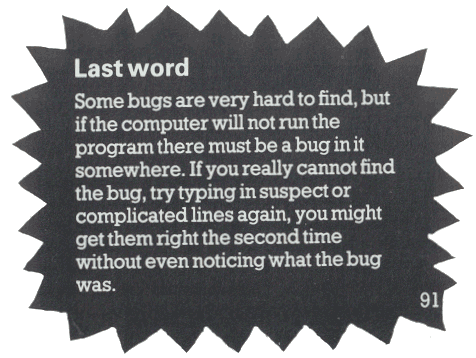
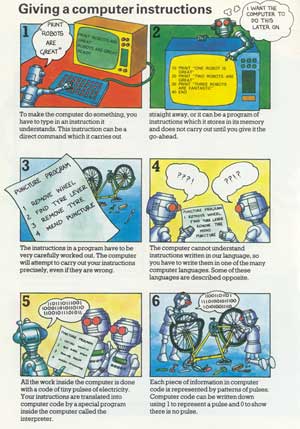
OMG! I used to (and probably still do) own a copy of that book - with a re-coloured BBC on the front and oodles of code: I wouldn't have been able to resist it (and, IIRC, my local library used to have a copy as well).
Ahh, happy memories ;)
I'm vaguely convinced that that book exists in my mother's house. She never throws anything away, and the pictures look really familiar.
Good find!
Guess what? I have this sitting on my desk in centre house at the mo...
Great post and yes at one stage I had a copy, it could be in the loft somewhere. But my BBC micro and the ZX80 are both in my garage (still working but now in boxes).
I like the 'Last Word' ballon above, what I remember most is trying to figure out if the magazine printed listing had keyed a ; instead of a , in their 'latest' game listing.
Ah! The joys of typing!!!